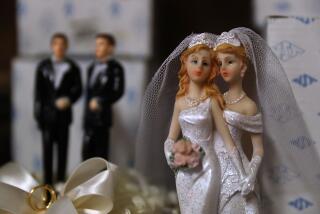The Road to Error Is Paved With Reason
- Share via
St. Augustine defined the difference between human reason and animal instinct as the ability to think about thinking.
Species lower on the food chain undoubtedly possess the innate capacity to relate concept to action, but only mankind displays evidence of the capability to ruminate about the nature of cause and effect. Until it can be proven that the sonar sounds of dolphins are actually group discussions about the vicissitudes of the tuna net, we will assume that the saint is correct in his understanding of the uniqueness of human thought.
The ability to reason, however, does not ensure that human beings are any more reasonable than animals governed only by instinct. Being able to think about thought does not make us thoughtful. Intelligence does not guarantee wisdom. As a matter of fact, our cognitive competence (relative to other mammals) may lead us into errors and dangers that mere instinct on even the most basic level would drive us to avoid. The human alone can think himself into situations that instinct and natural logic eschew. Because only humans can think about thinking, only humans can deceive themselves.
Blatant self-deception is rare outside the fanatic fringe. Fashionable postmodernism aside, the healthy human mind cannot truly convince itself that black is white. Most of us practice modified, dignified forms of self-deception that are less detectable and more socially acceptable than open defiance of accepted reasoning.
In America one of our favorite patterns of self-deception is a kind of imposed ambiguity. “I am not sure” is a far more secure answer in our culture than “I do not know.”
More often than not, “I am not sure” actually means “I know better, but I refuse to acknowledge it.” We pride ourselves on our ability to think about thinking, then scurry for cover under a blanket of self-serving, self-defined naivete.
Nowhere is this unattractive attribute of humanity more obvious than in our approach to art and religion. While these two exemplifications of culture have been forcibly divorced since the Enlightenment of the 18th century, they still share common abuse when it comes to public logic.
The artistic community was in apoplexy over popular and vocal opposition to an exhibit recently on display in Brooklyn. Those who define the cultural canon at the end of the millennium piously claimed that one man’s pornography is another man’s artistic expression, that what is tasteful or proper cannot be defined in absolute principles as such judgments are completely subjective.
No one really believes this.
How many times has a group of slavering frat boys discovered that the pledge responsible for renting Friday night’s videos got confused by the nuances of taste and rented “Gone With the Wind” instead of something with “Debbie” and “Does” in the title? How many traveling businessmen have guiltily pressed the “All-Night Entertainment” button on the hotel room’s remote control thinking they were really surfing the options for art? The only people who are unclear on the difference between vulgarity and propriety are those who think themselves into ambiguity so that they do not have to confront reality.
No one can blame someone for wishing to avoid the Solomonic problem of separating church and state in the United States. Few of us are up to a challenge that even the Supreme Court seems loath to confront. The issue, however, can neither be wished away nor swept under a carpet of self-imposed ambiguity.
No one is truly confused about the definition of religion. Religion is a set of beliefs and practices that defines one’s approach to life. In Christianity these indicators are codified in Scripture and creeds. In other religious expressions the parameters may not be as obvious but they are no less dogmatic.
Reciting the Bible as public policy is generally forbidden (except as pithy proverbs about secularly recognized truths). Incorporating the doctrines and customs of the Tao is acceptable. Why?
Eclectic borrowings from different forms of Taoism, Buddhism and thinly reconstituted Hinduism are fashionable in America today. They are embraced in government-sponsored institutions including schools as part of a healthy, sensitive, and progressive approach to life and relationships.
This does not violate the invisible wall of separation between religion and the state? Masquerading under the banner of philosophy, meditation, relaxation therapy or even exercise, Eastern religious belief and practice enjoy a protection and encouragement that if extended to Christianity would drive the ACLU into a feeding frenzy.
No one is honestly deceived. Everyone knows that the Ten Commandments are found in the Bible. Everyone knows that yin, yang, and chi are part of the canon of Taoism. Posting the Decalogue on the wall of City Hall would be called an invitation to litigation. Teaching tai chi at the Community Center is called responsible health management for our citizens. Unique among all creatures, only human beings could convince ourselves that this is consistent.
Dr. Samuel Scheibler is Rector of the Church of the Resurrection, Brea.
On Faith is a forum for Orange County clergy and others to offer their views on religious topics of general interest. Submissions, which will be published at the discretion of The Times and are subject to editing, should be delivered to Orange County religion page editor Jack Robinson.






